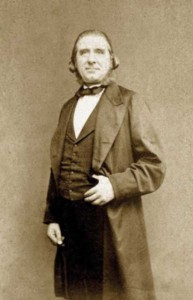‘Baron’ De Camin
Published in Uncategorized
Italian Alessandro Gavazzi—Protestant lecturers such as he and ‘Baron’ De Camin became minor celebrities in mid-nineteenth-century Britain.
That such public meetings were manipulated by respective Irish groups and transformed into little more than tribal rows between opposing groups of migrants is best seen through examination of the events surrounding a De Camin lecture in Wigan in 1859, which resulted in a week of fighting between Orange and Green factions. According to the Belfast Newsletter, upon hearing the news that De Camin was to give a lecture in Wigan on 2 July, crowds ‘of equal numbers of Roman Catholics and Protestants gathered in opposition outside the town hall’, upon which:
‘Their conduct was so threatening that the Mayor was forced to read the riot act to them. 100 Irishmen, armed with sticks and bludgeons, ran down the street in the direction of the hall, carrying all before them in a violent manner. The attacked party, consisting principally of Orangemen, charged their opponents, and after a general melee in which knives and bludgeons were brandished, the Irish were seen in full retreat up King Street.’
Following the violence outside the town hall, the Orange faction proceeded to attack predominantly Irish districts, resulting in open tribal warfare on Wigan’s streets. Detailing the violence that took place, the Wigan Observer commented:
‘The mob who were opposed to the Irish marched in the direction of Adelaide Street, where a large number of Irish reside. The mob, having armed themselves with weapons, now proceeded to attack “Kerfoots Row”, the scene of many a pitched battle. The Irish were forced to retreat and the Orangemen demolished every window on the street.’
We are therefore presented with evidence of the Orange manipulation of local religious and political concerns to further tribal divisions. Whatever the intended result of the Orange championing of anti-popery preachers in Wigan, the native populace appeared to take a dim view of both preacher and Orangemen. Examination of press reports and opinion pages supports the view that, although some within local society had sympathy for the claims of the Orange and anti-popery movements, the violence that became associated with them was viewed as little more than something working-class, foreign and troublesome.
After directly describing the violence as ‘a result of De Camin’s lecture’, the Wigan Observer continued: ‘the lecture was in the baron’s usual style, full of coarse and disgusting language’. Confirming the link between public preaching and Orange exploitation of local matters, the Times noted that ‘his audience was wholly composed of Orangemen, who would later victoriously demolish every Irish window in Wigan’.
















